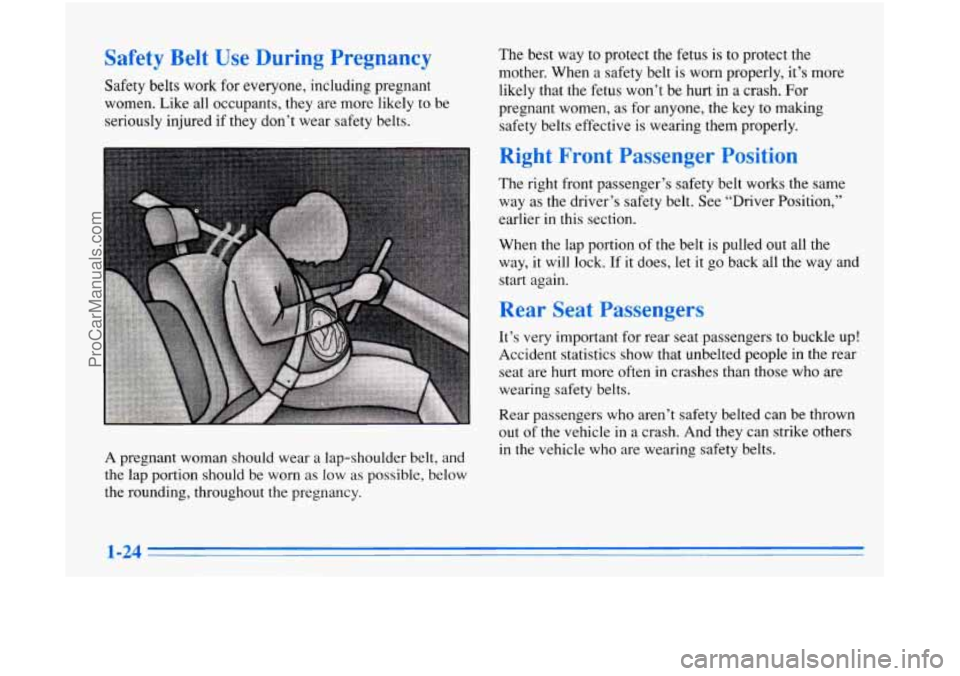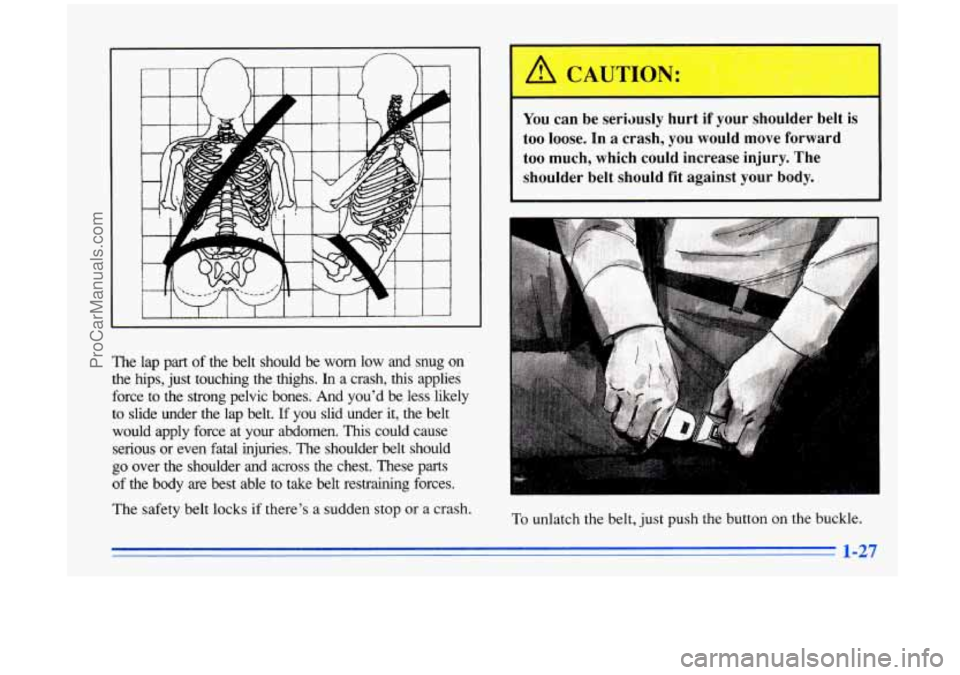OLDSMOBILE AURORA 1996 Owner's Guide
Manufacturer: OLDSMOBILE, Model Year: 1996, Model line: AURORA, Model: OLDSMOBILE AURORA 1996Pages: 388, PDF Size: 20.24 MB
Page 31 of 388

0
0 Your vehicle is equipped with a crash sensing and
diagnostic module, which records information about
the air bag system. The module records information
about the readiness of the system, when the sensors
are activated and driver’s safety belt usage at
deployment.
Let only qualified technicians work on your air bag
system. Improper service can mean that your air bag
system won’t work properly. See your retailer for Servicing Your Air Bag-Equipped Aurora
Air bags affect how your Aurora should be serviced.
There are parts of the air bag system in several places
around your vehicle. You don’t want the system to
inflate while someone is working on your vehicle. Your
Aurora retailer and the Aurora Service Manual have
information about servicing your vehicle and the air bag
system.
To purchase a service manual, see “Service and
Owner Publications’’ in the Index.
service.
NOTICE:
~
If you damage the cover for the driver’s or the
right front passenger’s air bag, they may not
work properly.
You may have to replace the air
bag module in the steering wheel or both the air
bag module and the instrument panel for the
right front passenger’s air bag.
Do not open or
break the air bag covers. For up to
10 minutes after the
ignition key is
turned off and the battery is disconnected, an air
bag can still inflate during improper service.
You
can be injured if you are close to an air bag when
it inflates. Avoid wires wrapped with yellow tape
or yellow connectors. They are probably part of
the air bag system. Be sure to follow proper
service procedures, and make sure the person
performing work for
you is qualified to do so.
The air bag system does not need regular maintenance.
ProCarManuals.com
Page 32 of 388

Safety Belt Use During Pregnancy
Safety belts work for everyone, including pregnant
women. Like all occupants, they are more likely to be
seriously injured if they don’t wear safety belts.
A pregnant woman should wear a lap-shoulder belt, and
the lap portion should be worn as low as possible, below
the rounding, throughout the pregnancy. The
best way
to protect the fetus is to protect the
mother. When a safety belt is worn properly, it’s more
likely that the fetus won’t be hurt in
a crash. For
pregnant women, as for anyone, the key to making
safety belts effective is wearing them properly.
Right Front Passenger Position
The right front passenger’s safety belt works the same
way as the driver’s safety belt. See “Driver Position,”
earlier in this section.
When the lap portion of the belt is pulled out all the
way, it will lock.
If it does, let it go back all the way and
start again.
Rear Seat Passengers
It’s very important for rear seat passengers to buckle up!
Accident statistics show that unbelted people in the rear
seat are hurt more often in crashes than those who are
wearing safety belts.
Rear passengers who aren’t safety belted can be thrown
out of the vehicle
in a crash. And they can strike others
in the vehicle who
are wearing safety belts.
ProCarManuals.com
Page 33 of 388

Rear Seat Outside Passenger Positions
U
Lap-Shoulder Belt
The positions next to the windows have lap-shoulder
belts. Here’s how to wear one properly.
1. Pick up the latch plate and pull the belt across you.
Don’t
let it get twisted.
2. Push the latch plate into the buckle until it clicks.
ProCarManuals.com
Page 34 of 388

If the belt stops before it reaches the buckle, tilt the
latch plate and keep pulling until you can buckle
it.
Pull up on the latch plate to make sure it is secure.
If the belt is not long enough, see "Safety Belt
Extender" at the end
of this section. Make sure the
release button
on the buckle is positioned so you
would be able to unbuckle the safety belt quickly
if
you ever had to.
3. To make the lap part tight, pull down on the buckle
end of the belt as you pull up
on the shoulder part.
ProCarManuals.com
Page 35 of 388

The lap part of the belt should be worn low and snug on
the hips, just touching the thighs.
In a crash, this applies
force to the strong pelvic bones. And you’d
be less likely
to slide under the lap belt. If you slid under it, the belt
would apply force at your abdomen. This could cause
serious or even fatal injuries. The shoulder belt should
go over the shoulder and across the chest. These parts
of the body are best able to take belt restraining forces.
The safety belt locks if there’s
a sudden stop or a crash.
You can be serimsly hurt if your shoulder belt is
too loose. In a crash, you would move forward
too much, which could increase injury. The
shoulder belt should fit against your
body.
To unlatch the belt, just push the button on the buckle.
- 1-27
ProCarManuals.com
Page 36 of 388

Rear Safety Belt Comfort Guides for
Zhildren and Small Adults
Rear shoulder belt comfort guides will provide added
safety belt comfort for children who have outgrown
child restraints and for small adults. When installed on
a
shoulder belt, the comfort guide pulls the belt away
from the neck and head.
There is one guide for each outside passenger position in
the rear seat.
To provide added safety belt comfort for
children who have outgrown child restraints and for
smaller adults, the comfort guides may be installed on
the shoulder belts. Here’s how to install a comfort guide
and use the safety belt:
1. Pull the elastic cord out from between the edge of
the seatback and the interior body to remove the
guide from its storage clip.
ProCarManuals.com
Page 37 of 388

2. Slide the guide under and past the belt. The elastic
cord must be under the belt. Then, place the guide
over the belt, and insert the two edges
of the belt into
the slots
of the guide.
3. Be sure that the belt is not twisted and it lies flat.
The elastic cord must be under the belt and the guide
on top.
ProCarManuals.com
Page 38 of 388

To remove and store the cornfort guides,’just perform
these steps in reverse order. Squeeze the belt edges
together
so that you can take them out from the guides.
Pull the guide upward to expose its storage clip, and
then slide the guide onto the clip. Rotate the guide and
clip inward and
-in between the seatback and the interior
body, leaving only the loop
of elastic cord exposed.
Center Passenger Position
U
4. Buckle, position and release the safety belt as
described in “Rear Seat Outside Passenger Positions”
earlier
in this section. Make sure that the shoulder
belt crosses the shoulder.
1-30
ProCarManuals.com
Page 39 of 388

Lap Belt
To make the belt shorter, pull its free end as shown until
the belt is snug.
When you sit in the center seating position, you have a
lap safety belt, which has no retractor.
To make the belt
longer, tilt the latch plate and pull it along the belt. Buckle, position
and release it the same way as the lap
part of a lap-shoulder belt. If the belt isn’t long enough,
see “Safety Belt Extender” at the end of
this section.
Make sure the release button on the buckle is positioned
so you would be able to unbuckle the safety belt quickly
if you ever had to.
1-31
ProCarManuals.com
Page 40 of 388

Children Smaller Children and Babies
Everyone in a vehicle needs protection! That includes 1
infants and all children smaller than adult size. In fact,
the law in every state in the United States and in every
Canadian province says children
up to some age must be
restrained while in
a vehicle. Smaller children and babies should always
be
restrained in
a child or infant restraint. The
instructions for the restraint will
say whether it is
the right type and size for your child.
A very
young child’s hip bones are
so small that a
regular belt might not stay low on the hips, as it
should. Instead, the belt will likely be over the
child’s abdomen. In
a crash, the belt would apply
force right on the child’s abdomen, which could
cause serious or fatal injuries.
So, be sure that
any child small enough for one is always properly
restrained in
a child or infant restraint.
ProCarManuals.com